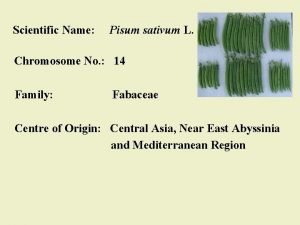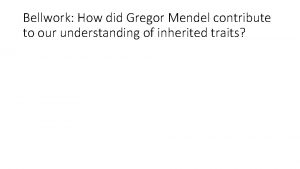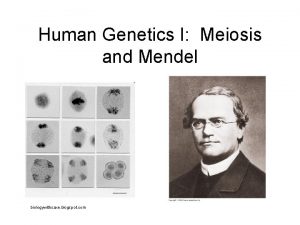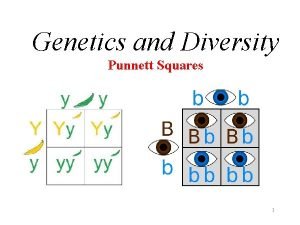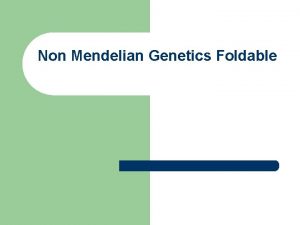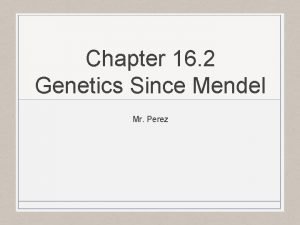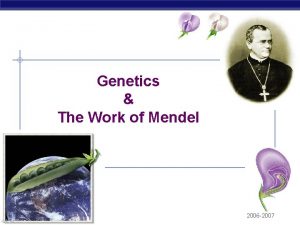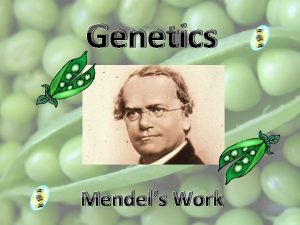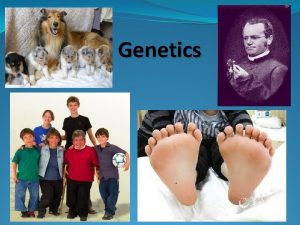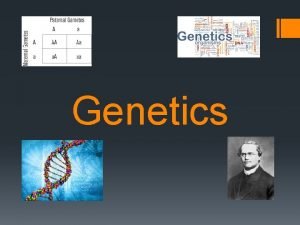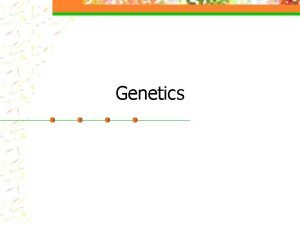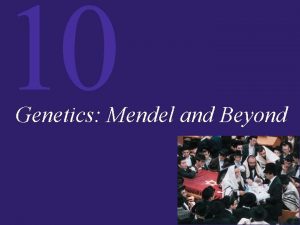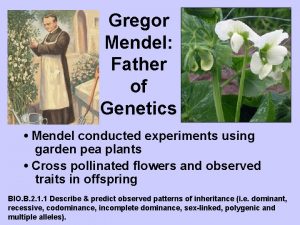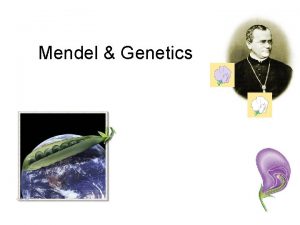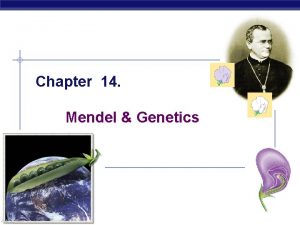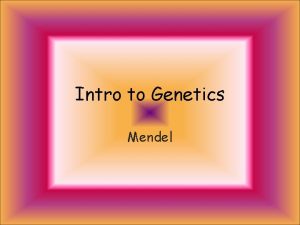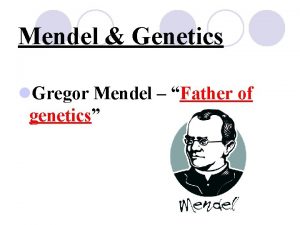Genetics and Mendel Mendels Work Mendels pea experiments
















- Slides: 16

Genetics and Mendel

Mendel’s Work • Mendel’s pea experiments led him to conclude that inheritance is determined by factors (genes) passed from one generation to the next. • These factors control all the various traits of an organism and may come in different forms (alleles).

Principle of Dominance • For a specific gene one allele for a trait is dominant over the others (recessive). – If the dominant allele is present, this is the characteristic the organism displays. – The only time the recessive allele is expressed is if there is NO dominant allele.

Dominance The F 1 generation from a cross of true-breeding plants are all Hybrids. The F 2 generation shows the return of the recessive allele.

Segregation • Mendel showed that the recessive allele does not disappear. Crossing 2 Hybrid plants (F 1) produced offspring that exhibited the recessive allele once again. • For all the F 2 offspring produced about ¼ of them exhibited the recessive allele. • 3: 1 ratio of Dominant: Recessive traits displayed.

Segregation • How did this occur? • Mendel suggested that the 2 alleles for a specific trait that an organism contains segregate during sex cell formation (meiosis). • Effectively, an organism will make two types of gametes: 1 type has one allele for a gene and the 2 nd type holds the other allele. • This way, of the 2 possible alleles a parent can contribute to offspring only one allele from each parent and becomes somewhat a game of chance.

Punnett Squares • We can use Punnett Squares to predict the outcome of a genetic cross for a particular trait. – Homozygous: Contains 2 of the same allele for a trait. – Heterozygous: Contains 2 different alleles for a trait (hybrids!) – Genotype: The genetic makeup of an organism for a trait. – Phenotype: The physical characteristic displayed for a specific trait.

Independent Assortment • Mendel then looked at the bigger picture. What happens to all of the genes of an organism during gamete formation. • Does segregation of one gene influence another? In other words as one gene segregates does it impact the segregation of another? • Mendel examined a cross of plants for two specific traits

Independent Assortment • He crossed a plant that was Homozygous for yellow round peas (YYRR) with a plant that was Homozygous wrinkled green peas (yyrr). • The F 1 generation was all yellow round as expected. – What’s their genotype? _____

Independent Assortment • Mendel then let the plants self-pollinate (just as before) to produce the F 2 generation. • Of the resulting F 2 generation every possible combination of traits were shown. – 556 seeds produced 315 were round/yellow. – 32 were wrinkled/green – 209 were a combination of phenotypes round/green and wrinkled/yellow – The results supports the idea that traits segregate separately.

Independent Assortment • Genes for different traits segregate independently during the formation of gametes. • One gene’s segregation does not influence another’s.

Exceptions to Mendel • Mendel’s findings and rules hold true for many cases in genetics. But there are some exceptions. (Figures, right? ) • Some genes do not have a dominant or recessive form, and some have more than just 2 alleles.

Incomplete Dominance • One allele is not dominant over another. • The result of these crosses produce heterozygous offspring showing traits between both homozygous parents. • Example: snapdragon

Codominance • Similar to incomplete dominance. In codominant cases both alleles contribute to the organism’s phenotype. • What you see is both phenotypes being expressed! • Example: Roan cattle; color of chicken feathers

Multiple Alleles • Many genes have more than 2 possible forms (alleles) in a population. • Makes for greater diversity for a trait. • Example: Blood type in humans

Polygenetic Traits • Not every trait is controlled by one gene. Often, multiple genes influence how certain traits are displayed. • Traits controlled by two or more genes are said to be polygenetic. • Example: Skin color in humans, fruit fly eye color.
 Economic importance of chickpea
Economic importance of chickpea Gregor mendels principles of genetics apply to
Gregor mendels principles of genetics apply to Mendelian laws
Mendelian laws Mendel and his peas lesson 1
Mendel and his peas lesson 1 Pp
Pp Mendel genetics
Mendel genetics Chapter 11 biology test
Chapter 11 biology test How did gregor mendel contribute to genetics
How did gregor mendel contribute to genetics Mendel genetics
Mendel genetics Blue eyed father brown eyed mother
Blue eyed father brown eyed mother Mendel's genetics foldable
Mendel's genetics foldable Genetics since mendel
Genetics since mendel Gregor mendel plant
Gregor mendel plant Section 11–1 the work of gregor mendel
Section 11–1 the work of gregor mendel Chapter 12 lesson 1 the work of gregor mendel
Chapter 12 lesson 1 the work of gregor mendel Chapter 12 lesson 1 the work of gregor mendel
Chapter 12 lesson 1 the work of gregor mendel Mendel work
Mendel work
